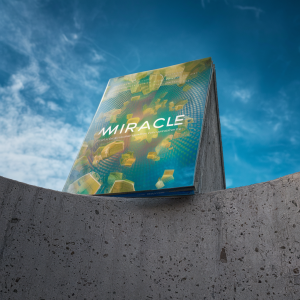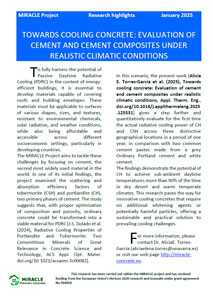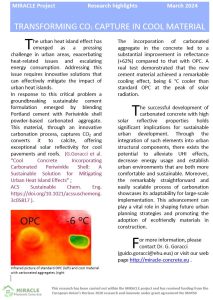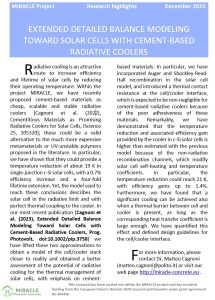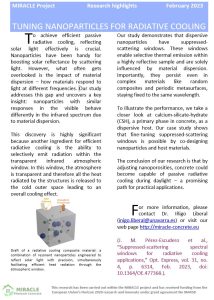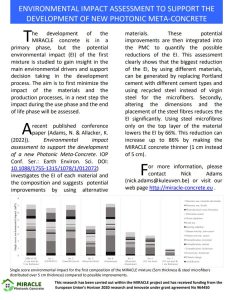Documents & Media

Miracle Flyer
MIRACLE stands for “Photonic Metaconcrete with Infrared RAdiative Cooling capacity for Large Energy savings”
Radiative cooling technology utilizes the atmospheric transparency window in the infrared range (8-13 μm wavelength) to passively dissipate heat from surfaces to outer space. This technology takes advantage of the fact that the Earth’s atmosphere is transparent to certain infrared wavelengths, allowing heat in the form of infrared radiation to escape into the cold vastness of space, which acts as an infinite heat sink at a temperature of around 3 Kelvin (-270°C).
Miracle news letters
January 2025
March 2024
Heat Transport Through Portlandite Molecule
MIRACLE researchers pushed forward in understanding heat transport mechanisms in portlandite, a key component of cement, at the molecular level. Through advanced molecular dynamics simulations and experimental techniques, the team quantified the contributions of different molecular groups to thermal conductivity.
Notably, they discovered that boson-peak excitations play a crucial role in controlling heat transport in portlandite crystals. These fundamental insights into the structure-property relationships of cement components pave the way for developing innovative cement formulations with enhanced thermal properties.
This research brings us one step closer to the development of thermally optimized, eco-friendly concrete for the cities of the future.
January 2024
Transforming CO2 Capture In Cool Material
MIRACLE Researchers have developed a groundbreaking sustainable cement formulation that incorporates carbonated periwinkle shell aggregates. Through an innovative carbonation process, this “cool concrete” captures CO2 and converts it into calcite, providing exceptional solar reflectivity.
In real tests, this material achieved a remarkable 6°C cooling effect compared to standard concrete at peak solar radiation, with a 62% improvement in reflectance.
The successful development of this highly reflective, carbonated concrete has significant implications for mitigating urban heat island effects, reducing energy consumption, and promoting more sustainable and comfortable urban environments. The straightforward and scalable carbonation process makes this solution well-suited for large-scale implementation in urban planning and construction using eco-friendly materials.
December 2023
Modeling Solar Cells with Cement Coolers
Within the MIRACLE project, researchers have proposed using cement-based materials as cost-effective and stable radiative coolers for solar cells. These materials could provide an alternative to expensive metamaterials or UV-unstable polymers.
Initial modeling showed that cement-based coolers could reduce the operating temperature of single-junction crystalline silicon (c-Si) solar cells by around 19°C, increasing efficiency by 0.7% and extending lifetime four-fold. However, this model assumed the radiative limit and perfect thermal coupling between the cell and cooler.
Recent work has incorporated more realistic conditions, including Auger and Shockley-Read-Hall recombination in the solar cell model and a thermal contact resistance at the cell/cooler interface. Remarkably, this extended model predicts even higher temperature reductions of up to 21°C and efficiency gains of up to 1.4% for c-Si cells with cement coolers. The researchers also provide guidelines on optimizing the thermal interface between cell and cooler. For more details, please download following document.
February 2023
Tuning Nanoparticles For Radiative Cooling
This MIRACLE research focuses on using nanoparticles to achieve efficient passive radiative cooling of buildings and structures. The key finding is that nanoparticles with similar optical responses in the visible spectrum can behave differently in the infrared due to material dispersion effects. This allows engineering nanoparticle composites that can selectively reflect sunlight while also emitting thermal radiation through the atmospheric window, enabling passive cooling by radiating heat to outer space.
The study demonstrates the existence of “suppressed-scattering windows” in dispersive nanoparticle composites that enable this selective thermal emission within a highly reflective material. As a case study, calcium-silicate-hydrate (a major concrete component) was investigated as a dispersive host material. By tuning the nanoparticle properties and host porosities, it may be possible to make concrete capable of passive radiative cooling during daylight hours. This represents a promising practical application of the research findings.
November 2022
Environmental Impact Assessment of New Photonic Meta-Concrete
The MIRACLE project is developing a new type of photonic meta-concrete that can potentially provide radiative cooling for solar cells. An environmental impact assessment was conducted on the initial concrete mixture composition, identifying that the biggest reductions in environmental impact could come from replacing ordinary Portland cement with alternative low-carbon cement types, using recycled steel instead of virgin steel for the reinforcing fibers, and optimizing the dimensions and placement of the steel fibers.
The MIRACLE project is developing a new type of photonic meta-concrete with enhanced properties. An environmental impact assessment was conducted on the initial concrete mixture composition to identify areas for improvement. The study found that using alternative cement types instead of ordinary Portland cement and recycled steel instead of virgin steel for the microfibers can significantly reduce the environmental impact.
Additionally, optimizing the dimensions and placement of the steel fibers, such as using them only in the top layer or reducing the overall thickness, can lead to substantial impact reductions of up to 86%.
This research provides valuable insights to guide the development of an eco-friendlier photonic meta-concrete. The full details are available in the document “Environmental impact assessment to support the development of a new Photonic Meta-Concrete” by Adams and Allacker, which can be downloaded from the following link.
October 2022
Radiative Cooling of Solar Cells Using Cement-Based Materials
Miracle researchers have developed a potential new radiative cooling solution for solar cells using ordinary cement-based materials. Traditional radiative coolers rely on expensive materials or complex fabrication, but this cement approach aims to provide an efficient, cost-effective, scalable and robust alternative.
Through multi-scale simulations, the researchers showed that ordinary Portland cement can be engineered to have suitable electromagnetic properties for radiative cooling applications for solar cells. Their analysis found the thermodynamic limit of this cement-based radiative cooling approach could reduce the operating temperature of solar cells by around 20°C.
This temperature reduction corresponds to potentially increasing the efficiency of silicon solar cells by up to 9% and extending their lifetime by up to 4 times. While just an initial step, this cement radiative cooling concept combines energy, economic, reliability and scalability advantages. Further research is expected to work towards practically realizing this promising approach. More in the following document.
Press release
The revolutionary MIRACLE project to develop a new type of concrete that can help reduce urban heat and energy costs has garnered significant media interest. Major news outlets such as El Correo, El Confidencial, Le Soir, and Telecinco have reported on this groundbreaking initiative.
PATENTS
New designs of cement-based materials capable of Daytime radiative cooling capacity.
A daytime radiative cooling cementitious composite (DRCCC). EP23382854.0. Jorge S. Dolaldo, Guido Goracci, Andrés Ayuela, Silvia Arrese-Igor, Miguel Beruete, Iñigo Liberal, Carlos Lezaun, Alicia Torres, José Manuel Pérez-Escudero, Juan José Gaitero, Achutha Prabhu, Edduardus Koenders, Christophe Mankel, Neven Ukraincyk, Ignacio Peralta, Matteo Cagnoni, Federica Capelluti, Antoine Sylvander, Denis Barbier, Karen Allacker, Nick Adams.

Scientific publications
- Thermal properties of tricalcium aluminate: Molecular dynamics simulation and experimental approach. Prodip Kumar Sarkar, Guido Goracci, Jorge S. Dolado. Cement and Concrete Research, Volume 189, 2025, 107780, https://doi.org/10.1016/j.cemconres.2024.107780
- Towards cooling concrete: Evaluation of cement and cement composites under realistic climatic conditions, Alicia E. Torres-García, Ridwan O. Agbaoye, Laura Carlosena, Guido Goracci, Carlos Lezaun, Jorge S. Dolado, Miguel Beruete. Applied Thermal Engineering, Volume 265, 2025, 125531. https://doi.org/10.1016/j.applthermaleng.2025.125531
-
Thermoelectric properties of the main species present in Portland cement pastes. Ridwan O. Agbaoye, Jozef Janovec, Andrés Ayuela, Jorge S. Dolado. Cement and Concrete Research, Volume 183, 2024, 107587. https://doi.org/10.1016/j.cemconres.2024.107587.
- Extended detailed balance modeling toward solar cells with cement-based radiative coolers. Cagnoni M, Testa P, Dolado JS, Cappelluti F.. Prog Photovolt Res Appl. 2025; 33(1): 54-63. doi:10.1002/pip.3758
- Evaluating the cradle-to-gate environmental impact and cooling performance of advanced daytime radiative cooling materials to establish a comparative framework for a novel photonic meta-concrete. N. Adams, L. Carlosena & K. Allacker. Environ Sci Eur 36, 178 (2024). https://doi.org/10.1186/s12302-024-01005-5
- Thermal conductivity of layered minerals using molecular dynamics simulation: A case study on calcium sulfates. Prodip Kumar Sarkar; Nilanjan Mitra; Jorge S. Dolado. Materials Today Communications, Volume 38, March 2024, 108101. https://doi.org/10.1016/j.mtcomm.2024.108101.
- Refractory and thermoelectric properties of stabilized Tricalcium aluminate allotrope: A first-principles calculation approach. Ridwan O. Agbaoye; Andres Ayuela; Jorge S. Dolado. Materials Today Communications, Volume 39, 2024, 108757. https://doi.org/10.1016/j.mtcomm.2024.108757
- Kaolin Clay-Based Geopolymer for Ionic Thermoelectric Energy Harvesting. Guido Goracci; Mary B. Ogundiran; Mohamad Barzegar; Amaia Iturrospe; Arantxa Arbe; Jorge S. Dolado. ACS Omega 2024, 9, 12, 13728–13737 Publication Date:March 11, 2024. https://doi.org/10.1021/acsomega.3c08257
- Cool Concrete Incorporating Carbonated Periwinkle Shell: A Sustainable Solution for Mitigating Urban Heat Island Effects. Guido Goracci; Ebtisam Saeed; Mary B. Ogundiran; Amaia Iturrospe; Arantxa Arbe; Cyril Aymonier; Jorge S. Dolado. ACS Sustainable Chem. Eng. 2024, 12, 5, 1911–1917. https://doi.org/10.1021/acssuschemeng.3c05817
- Thermal conductivity of Portlandite: Molecular dynamics based approach. Prodip Kumar Sarkar; Guido Goracci; Jorge S. Dolado. Cement and Concrete Research, Volume 175, January 2024, 107347. https://doi.org/10.1016/j.cemconres.2023.107347
- Passive radiative cooling of solar cells by low-cost and scalable metamaterials: physical simulation and efficiency limits. Cagnoni, Matteo; Tibaldi, Alberto; Testa, Pietro; Sánchez Dolado, Jorge; Cappelluti, Federica.Proceedings Volume 11996, Physics, Simulation, and Photonic Engineering of Photovoltaic Devices XI. https://doi.org/10.1117/12.2607489
- Computational design of a Massive Solar-Thermal Collector enhanced with Phase Change Materials. Peralta, Ignacio; Fachinotti, Víctor D.; Koenders, Eddie A.B.; Caggiano, Antonio. Energy and Buildings. https://doi.org/10.1016/j.enbuild.2022.112437 http://hdl.handle.net/10261/279827
- Environmental impact assessment to support the development of new Photonic Meta-Concrete. Adams, Nick; Allacker, Karen. IOP Conference Series – Earth and Environmental Science. https://doi.org/10.1088/1755-1315/1078/1/012072
- Enhancing the infrared and visible emission properties of calcium silicate hydrate for radiative cooling using metamaterial. Carlos Lezaun; Jorge S. Dolado; Alicia E. Torres; José M. Perez-Escudero; Iñigo Liberal; Miguel Beruete. 2022 47th International Conference on Infrared, Millimeter and Terahertz Waves (IRMMW-THz). https://doi.org/10.1109/irmmw-thz50927.2022.9895888
- Development and potential environmental impact of Photonic Meta-Concrete. N Adams, K Allacker and J S Dolado. IOP Conf. Series: Earth and Environmental Science 1085 (2022) 012053. https://doi.org/10.1088/1755-1315/1085/1/012053
- Cementitious Materials as Promising Radiative Coolers for Solar Cells. Cagnoni, Alberto Tibaldi, Jorge Sánchez Dolado, Federica Cappelluti. iScience https://doi.org/10.1016/j.isci.2022.105320
- Suppressed-scattering windows for radiative cooling applications. José M. Pérez-Escudero, Alicia E. Torres-García, Carloz Leazun, Antonio Caggiano, Ignacio Peralta, Jorge S. Dolado, Miguel Beruete, Iñigo Liberal. Submitted and uploaded in arXiv (https://arxiv.org/abs/2210.06940)
- Extended detailed balance modeling toward solar cells with cement-based radiative coolers. Cagnoni, Matteo, Pietro Testa, Jorge S. Dolado, and Federica Cappelluti. https://doi.org/10.1002/pip.3758
- Radiative Cooling Properties of Portlandite and Tobermorite: Two Cementitious Minerals of Great Relevance in Concrete Science and Technology. Dolado, Jorge S., Guido Goracci, Silvia Arrese-Igor, Andrés Ayuela, Angie Torres, Iñigo Liberal, Miguel Beruete, Juan J. Gaitero, Matteo Cagnoni, and Federica Cappelluti. https://doi.org/10.1021/acsaom.3c00082
- Suppressed-scattering spectral windows for radiative cooling applications. José M. Pérez-Escudero, Alicia E. Torres-García, Carlos Lezaun, Antonio Caggiano, Ignacio Peralta, Jorge S. Dolado, Miguel Beruete, and Iñigo Liberal. https://doi.org/10.1364/OE.477368
- Cementitious materials as promising radiative coolers for solar cells. Cagnoni, Matteo, Alberto Tibaldi, Jorge S. Dolado, and Federica Cappelluti. https://doi.org/10.1016/j.isci.2022.105320
Video
MIRACLE VIDEO
MIRACLE IN A NUTSHELL (PPT VIDEO)

